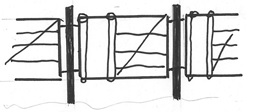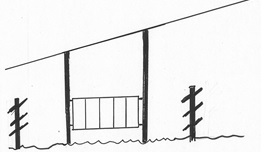Safety In Large Cattle Pens
7 June 2017I was recently asked to visit a farm to discuss the safety of staff when working in large pens of cattle. The shed used to be a cubicle shed but had been converted to 3 large, oblong straw bedded pens with access to feed troughs across one of the short ends. The pens were approximately twice as long as they were wide, with each holding around 50 pregnant cows. Standing in the middle of the pen it felt a long way to reach safety! Eventually we ended up with 2 proposals.
Man escapes
The pen divisions were made from traditional metal uprights with gates bolted in between. It was decided that one simple option would be to adjust the gates to incorporate a man “escape” at one end. To speed getting through it was suggested making each side of the gap out of rollers would help save vital seconds and avoid clothing being snagged etc.
The shed was made out of 2 spans so that there were large RSJs in each pen almost exactly dividing it into 2 halves. It was decided to hang a frame between 2 of the uprights with vertical rather than horizontal bars so that each made a potential man escape. Although the gates would be pinned in position, to make them as ridged as possible, the pins on one side would be easily removed to allow bales of straw to be rolled out, the shed to be mucked out, etc. The idea was that should a cow become dangerous it would be easy to slip though and, should she come round to the other side, slip back again.
At one point we discussed the possibility of having one gap in the frame as a ladder so staff could climb up out of the way. However with a really aggressive cow thumping the gate we felt it would not be very stable. In addition should the cow rear up on her back legs, her head could easily reach the top rail and knock somebody off.
Visibility
An interesting point which arose was the importance of cows being able to see clearly all around to minimise the risk of them being spooked and stampeding. Unfortunately the vast majority of sheds built in the late 1900’s seem to make maximum use of breeze block walls which as well as minimising visibility, reduced air movement/ventilation and were expensive. Fortunately the trend today for an umbrella roof with no walls is a major step forward.
Basil Lowman, basil.lowman@sac.co.uk
Sign up to the FAS newsletter
Receive updates on news, events and publications from Scotland’s Farm Advisory Service


